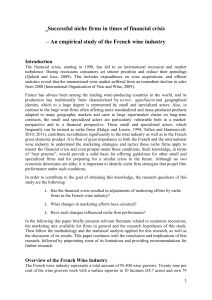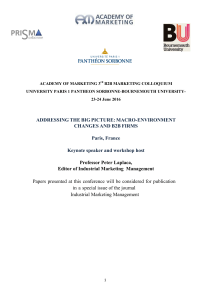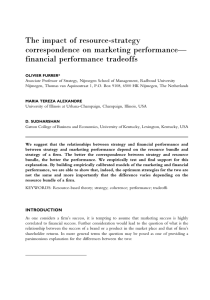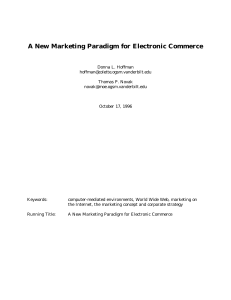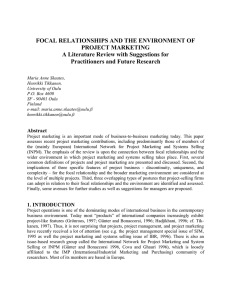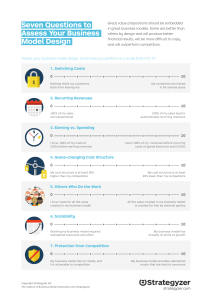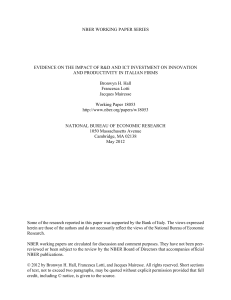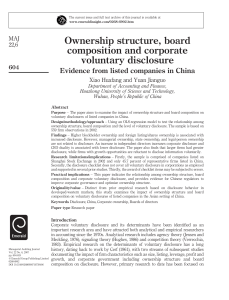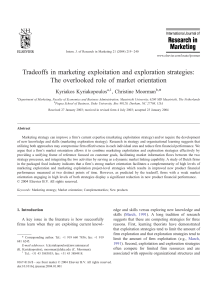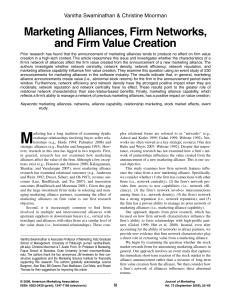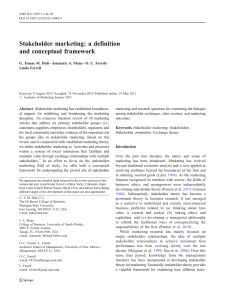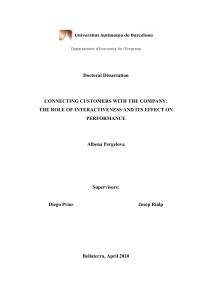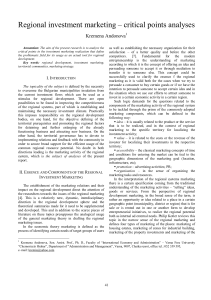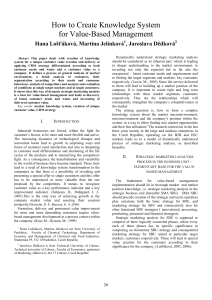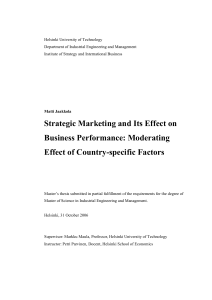Success of Marketing Approach of High–Tech Iveta Šimberová
publicité
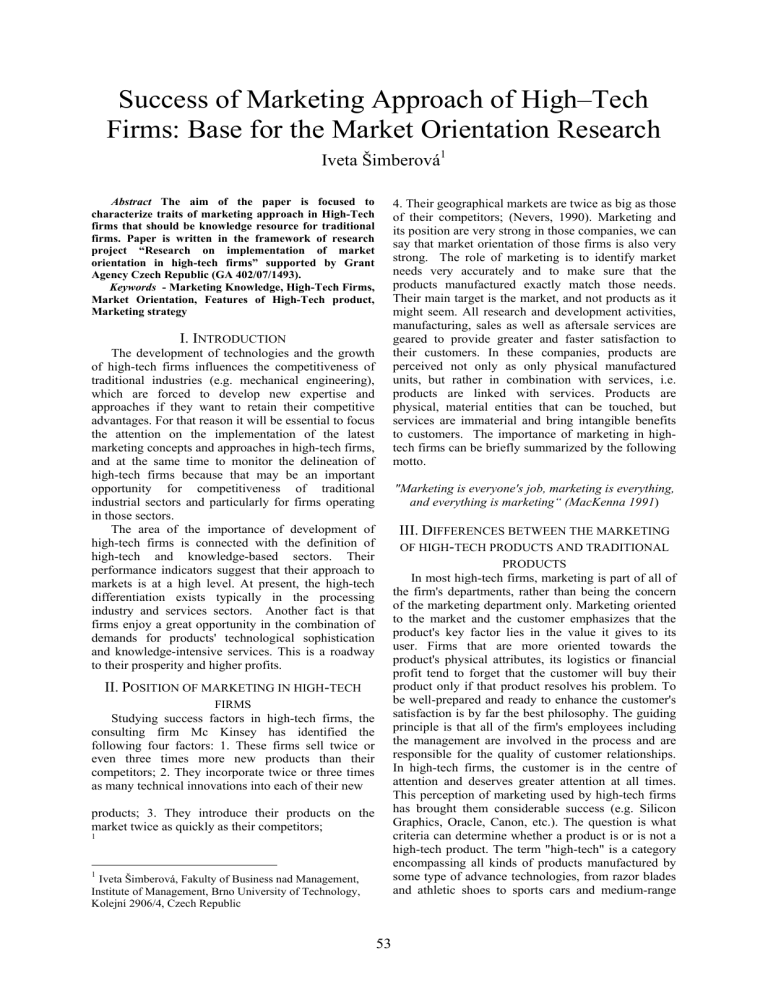
Success of Marketing Approach of High–Tech Firms: Base for the Market Orientation Research Iveta Šimberová1 Abstract The aim of the paper is focused to characterize traits of marketing approach in High-Tech firms that should be knowledge resource for traditional firms. Paper is written in the framework of research project “Research on implementation of market orientation in high-tech firms” supported by Grant Agency Czech Republic (GA 402/07/1493). Keywords - Marketing Knowledge, High-Tech Firms, Market Orientation, Features of High-Tech product, Marketing strategy 4. Their geographical markets are twice as big as those of their competitors; (Nevers, 1990). Marketing and its position are very strong in those companies, we can say that market orientation of those firms is also very strong. The role of marketing is to identify market needs very accurately and to make sure that the products manufactured exactly match those needs. Their main target is the market, and not products as it might seem. All research and development activities, manufacturing, sales as well as aftersale services are geared to provide greater and faster satisfaction to their customers. In these companies, products are perceived not only as only physical manufactured units, but rather in combination with services, i.e. products are linked with services. Products are physical, material entities that can be touched, but services are immaterial and bring intangible benefits to customers. The importance of marketing in hightech firms can be briefly summarized by the following motto. I. INTRODUCTION The development of technologies and the growth of high-tech firms influences the competitiveness of traditional industries (e.g. mechanical engineering), which are forced to develop new expertise and approaches if they want to retain their competitive advantages. For that reason it will be essential to focus the attention on the implementation of the latest marketing concepts and approaches in high-tech firms, and at the same time to monitor the delineation of high-tech firms because that may be an important opportunity for competitiveness of traditional industrial sectors and particularly for firms operating in those sectors. The area of the importance of development of high-tech firms is connected with the definition of high-tech and knowledge-based sectors. Their performance indicators suggest that their approach to markets is at a high level. At present, the high-tech differentiation exists typically in the processing industry and services sectors. Another fact is that firms enjoy a great opportunity in the combination of demands for products' technological sophistication and knowledge-intensive services. This is a roadway to their prosperity and higher profits. "Marketing is everyone's job, marketing is everything, and everything is marketing“ (MacKenna 1991) III. DIFFERENCES BETWEEN THE MARKETING OF HIGH-TECH PRODUCTS AND TRADITIONAL PRODUCTS In most high-tech firms, marketing is part of all of the firm's departments, rather than being the concern of the marketing department only. Marketing oriented to the market and the customer emphasizes that the product's key factor lies in the value it gives to its user. Firms that are more oriented towards the product's physical attributes, its logistics or financial profit tend to forget that the customer will buy their product only if that product resolves his problem. To be well-prepared and ready to enhance the customer's satisfaction is by far the best philosophy. The guiding principle is that all of the firm's employees including the management are involved in the process and are responsible for the quality of customer relationships. In high-tech firms, the customer is in the centre of attention and deserves greater attention at all times. This perception of marketing used by high-tech firms has brought them considerable success (e.g. Silicon Graphics, Oracle, Canon, etc.). The question is what criteria can determine whether a product is or is not a high-tech product. The term "high-tech" is a category encompassing all kinds of products manufactured by some type of advance technologies, from razor blades and athletic shoes to sports cars and medium-range II. POSITION OF MARKETING IN HIGH-TECH FIRMS Studying success factors in high-tech firms, the consulting firm Mc Kinsey has identified the following four factors: 1. These firms sell twice or even three times more new products than their competitors; 2. They incorporate twice or three times as many technical innovations into each of their new products; 3. They introduce their products on the market twice as quickly as their competitors; 1 1 Iveta Šimberová, Fakulty of Business nad Management, Institute of Management, Brno University of Technology, Kolejní 2906/4, Czech Republic 53 their rapid development and aspect of innovation above all is their ability to satisfy needs and requirements. Some of high–tech products are manufactured in large quantities (e.g. cell phones), others are industry high-tech products, such as robots, which are unique and manufactured in small quantities. From the marketing point of view, the high-tech dimension is viewed as the "product's extra layer", an added value that is defined through its either tangible or intangible aspect related to the nature of its consumer or industrial market. From this point of view, a high-tech product - in the context of concrete cases - is either a consumer product or an industrial product or service. Marketing of high-tech products is nothing but a subsystem of marketing of consumer products, industrial products, or marketing of services. rockets. It is clear from the above that the delineation is too broad, and that there is no clear-cut definition of a high-tech product. Present-day advance technologies may be incorporated in any product (e.g. microprocessors in a washing machine or a car), but that does not make that product a high-tech product. When defining a high-tech product, we must take both the specific sector and the characteristics of the product into consideration. High-tech products are very closely linked with industries such as biotechnology, materials technologies, information technology, solar and nuclear energy, etc. It is assumed that exceptional progress will be achieved through those four areas that will lead to further development of many more high-tech products. The claim that these industries constitute at present evidence of progress can be substantiated among others by the volume of investment poured into them by countries and undertakings (e.g. investments of chemical and pharmaceutical firms into biotechnologies, aerospace and computer technologies, materials technologies, etc.). V. MARKETING STRATEGY IN HIGH-TECH FIRMS Just as any other firms, high-tech firms develop their marketing strategy as part of their corporate strategy, which is designed by the executive management to match the identified aims and resources with market opportunities. Specific characteristics of high-tech technologies, however, lead them to also use other tools when developing their strategies. The development and definition of a mission is not marked by anything different or special, but the identification of strategic sectors (segments) is far more important and, from the strategy development point of view, great attention needs to be paid to the evaluation of the firm from the point of view of the contribution of their technologies and their positioning according to the technology's life cycle (Fig 1). IV. CHARACTERISTIC FEATURES OF HIGHTECH PRODUCTS High-tech products can be characterized by four typical features (Viardot 1998): 1. These products have the latest research findings and sophisticated technologies built into them (examples of such a complex of technologies is protein include engineering, plasma techniques, multiprocessor computer architecture, recycling of nuclear flammables, etc.); 2. The products are developed and replaced at high rate (microprocessors are a typical example of such products); 3. They are characterized by their innovative quality and value, bring radical changes in the product life cycle, shorten the period after which one product on the market is replaced by another one. Each technology gives the product its own life cycle with all its four stages. 4. They are characterized by high requirements on investment into research and development. Customer needs Technology When characterizing high-tech products, their large variety need to be taken into account, often resulting in a situation that individual components may be excellent although the final product is not (e.g. components built into automatic washing machines, automobile engines or children's toys). This explains why standard products with only a few specific characteristics and which are intended for mass production might be just as excellent as the differentiated products. Thanks to their flexibility, differentiated products can satisfy various needs as they crop up with changing demand. This difference between different types of high-tech products is significant from the point of view of marketing methods used. Besides strict technical characteristics, Customer groups Fig. 1 Three dimensions of business interest (Abel . D.F.) 54 The third dimension of the strategic segmentation, i.e. technical know-how, is extremely important for the high-tech sector. Technology can be used as a powerful tool of differentiation between competitors. It is also important from the verification of market synchronization point of view, and it is also unavoidable from the point of view of the readiness for rapid changes in the high tech environment. It is also necessary to evaluate the innovative value of high-technologies from its competitive advantage perspective. The level of mastering future key technologies will certainly have very important competitive impact. After the corporate strategy regarding these key decisions has been approved, managers then can develop marketing strategies for marketing activities. This part of the process does not differ from traditional processes except that it must integrated high-tech industry specific characteristics in all of its elements. VII. DISCUSSION Topics relating to the position of marketing in high-tech firms and the use of marketing expertise in firms are becoming important lately, particularly from the point of view of a dynamic development of hightech firms. High-tech firms are most frequently established by people with a high level of technical expertise, who rely in their business activities mainly on the development of new products, innovations, highly skilled employees, trust in new products and the ability to identify gaps in the market (Murphy, Ledwith, 2007). The question is what is the level of their skills in economic and managerial disciplines, of which marketing is one. The ability of these undertakings to promptly respond to the needs and requirements of the market are becoming a suitable topic for research that might bring new findings in the area of market concept implementation. Market orientation is nowadays considered a new direction in market developments which could, among others, provide answers to current discrepancies between academic and practical levels of marketing knowledge, abilities and skills. The position of marketing and the use of marketing knowledge in high-tech firms are in many cases also linked to the ability of those firms to measure marketing activities in relation to the firms' performance levels, which is an area of particular interest not only for the firms' successful operation but especially for their managements and owners. The development of technologies and the growth of high-tech firms influences to a significant degree the competitiveness of traditional industries (e.g. mechanical engineering), which are forced to develop new expertise and approaches if they want to retain their competitive advantages. In our research into the implementation of market orientation by high tech companies we investigated industries usually designated as high-tech industries from the point of view of their approach to marketing and the use of marketing knowledge for their successful operation on permanently changing markets. The reason for the choice is our assertion that these firms can be assumed to demonstrate a high sensitivity and active approach to changes in market situations. VI. CONCLUSION The marketing strategy sets up a framework within which the firm's sales activities take place. Firms then develop suitable marketing plans, proceeding in a manner similar to that used for traditional products and services. The four basic steps are: • Situation analysis – its objective is to identify both opportunities and threats; every marketing strategy must include marketing objectives, sales diagrams, profits (methods of their calculation) and target markets; • For each target market the firm defines its marketing mix; product- includes also product testing, product portfolio scope management, modifications of existing products, formulation of brand name, developing product warranty and additional services; price- formulation of price policy from the point of view of competitors, customers, price elasticity, discounts, etc.; promotion - includes the identification of goals, selection of appropriate media for promotional, formulation of messages, developing advertisement messages, communication programmes; distribution- includes the selection of suitable distribution channels, monitoring distribution expenses; building effective programmes for distributors, etc. • The development of action programmes depends on the fast occurring changes in the high-tech area, for that reason those programmes must be made to allow for their flexible adaptations. Action programmes correspond with the implementation of each individual element of the marketing mix; • The plan of monitoring procedures (checks) should offer possibilities for a quick fix of the marketing strategy should one be needed. Bureaucratic businesses cannot survive on hightech markets. REFERENCES [1] MacKENNA, R. Marketing is everything. In Harvard Business Review, January-February 1991 [2] MURPHY, A., LEDWITH, A. Project management tools and techniques in high technology SMEs. In Management research news., vol.30, No. 2, 2007, ISSN 0140-9174 [3] VIARDOT, E. Successful marketing strategy for high-tech firms. 1st ed., USA: Artech House, 1998, 266p, ISBN 0-89006-854-2 55


